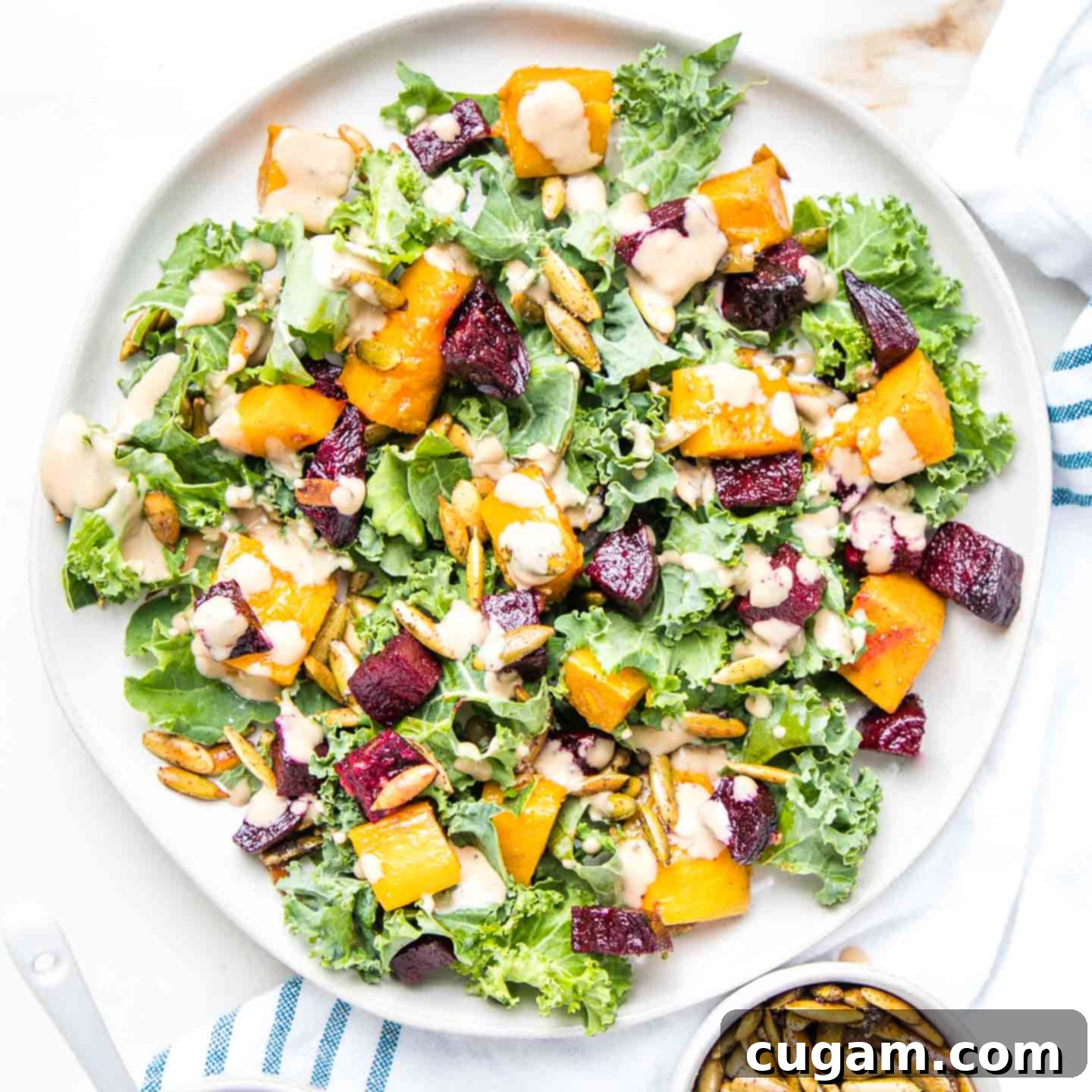Hearty & Healthy Roasted Butternut Squash and Beetroot Salad (Vegan & Gluten-Free)
Embrace the cozy flavors of autumn and winter with this incredibly delicious and vibrant Roasted Butternut Squash and Beetroot Salad. It’s a truly satisfying dish that brings together the best of seasonal produce with a crave-worthy, creamy, and entirely dairy-free balsamic dressing. This salad is so hearty and filling that it can easily stand alone as a complete meal, yet it’s also elegant and beautiful enough to be a show-stopping side dish for any holiday gathering, from Thanksgiving to Christmas.
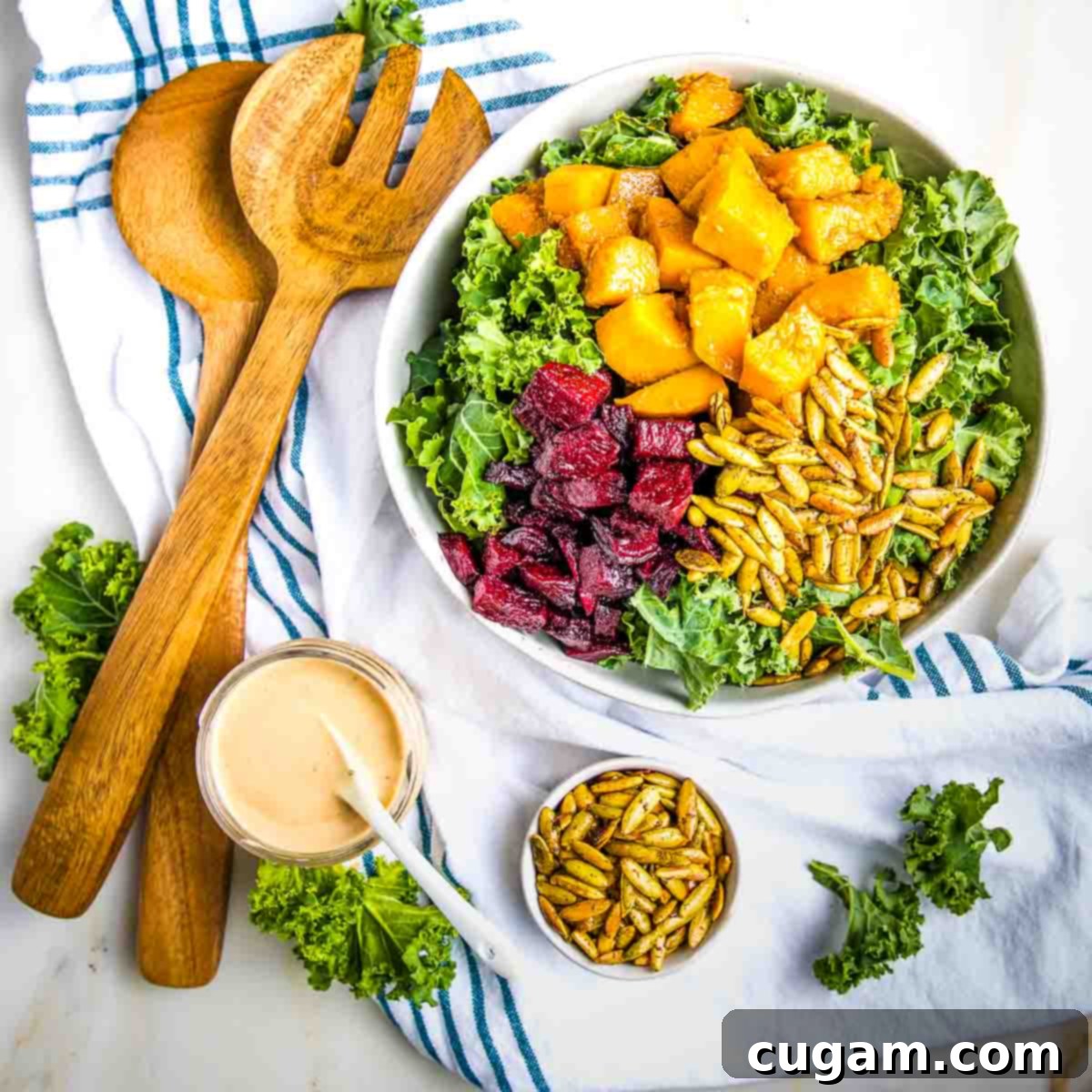
This post was updated from the original posted in 2016.
Jump to: Why You’ll Love It | Ingredients | Prep Squash | Roasting | Dressing | Assembly | Tips | More Recipes | Recipe Card
This butternut and beetroot salad is an absolute must-try for your fall and winter recipe repertoire! It’s remarkably easy to prepare, featuring fresh, vibrant, and seasonal ingredients that burst with flavor. You’re truly going to adore the warmly spiced roasted butternut squash, which adds a comforting sweetness to every bite. Trust me, this salad delivers a perfect symphony of tastes and textures: a delightful combination of roasty, creamy, spicy, and crunchy elements that will leave you completely obsessed.
And that dressing? Oh, it’s a game-changer! Honestly, just give me a bowl of this creamy balsamic dressing, and I’m sure I’ll get through the week. It’s perfect for drizzling generously over baked sweet potatoes and other roasted veggies, slathering onto your sandwiches and wraps, or soaking up all the delicious leftovers. You might even be tempted to use a straw!
Why You Will Absolutely Love This Salad
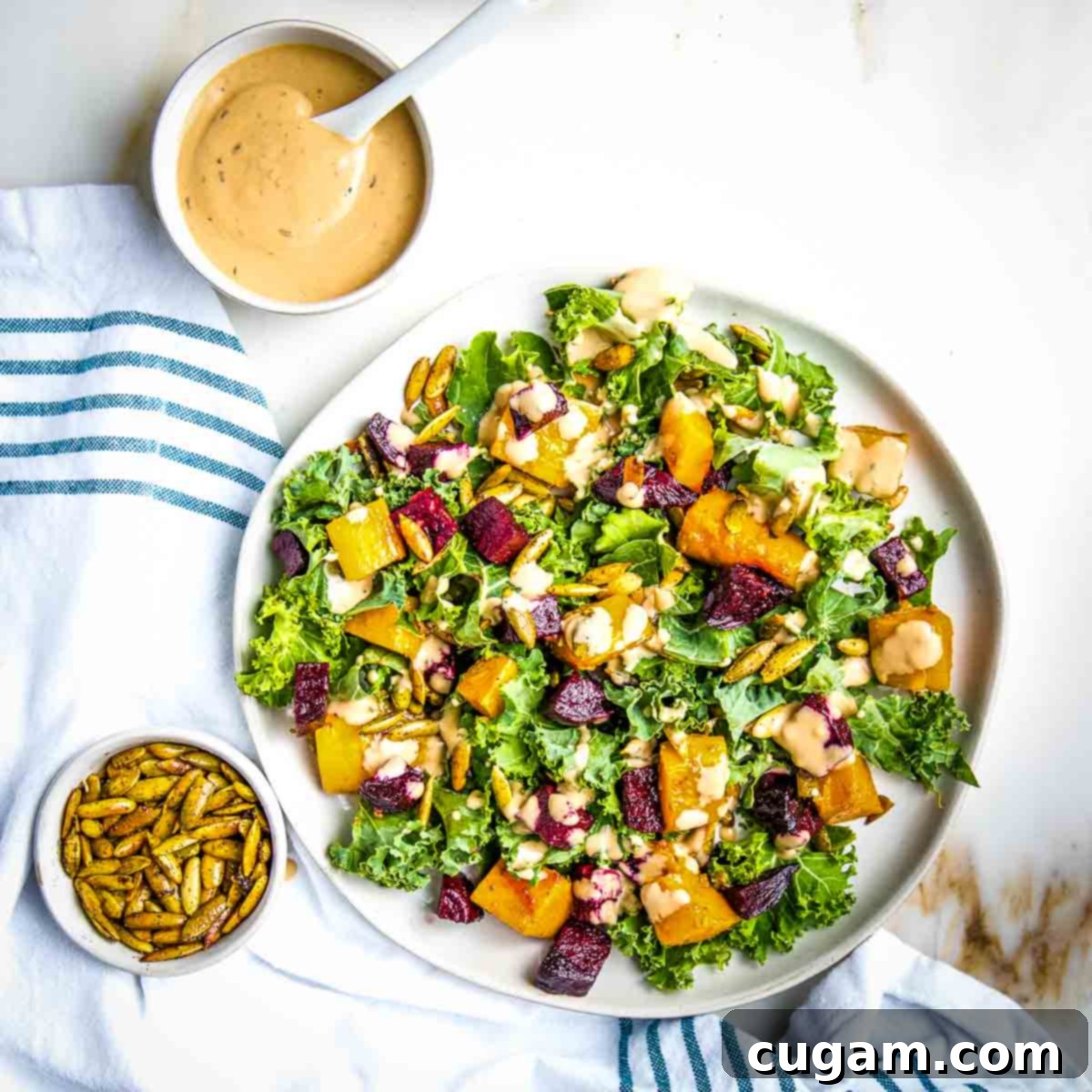
- Meal Prep Perfection: This salad is designed for efficiency! The roasted squash and beets stay fresh and delicious in the fridge for up to 5 days. Even better, the incredible dairy-free balsamic dressing can be made up to 2 weeks ahead, saving you precious time during busy weekdays. Assemble portions as needed for quick, healthy meals.
- Stunning Presentation: With its rich jewel tones and inviting textures, this salad is truly a feast for the eyes. It’s gorgeous enough to grace any holiday table, making it an instant favorite for Thanksgiving, Christmas, or any special occasion where you want to impress. Hello, favorite holiday salad!
- Bursting with Color: Not only is it incredibly pretty, but the diverse array of colors signifies a wide range of vitamins, minerals, and antioxidants. Eating the rainbow has never been so delicious!
- Nutrient-Rich Powerhouse: This salad is a nutritional dream, combining fiber-rich greens with antioxidant-packed root vegetables. Each bite delivers a potent dose of essential vitamins and minerals, all while tasting absolutely incredible.
- Explosion of Flavor: The butternut squash is lovingly spiced with warm sage and earthy cumin, which perfectly complements and brings out the natural savory and sweet goodness of all the vegetables. The creamy balsamic dressing ties everything together with a tangy, delightful finish.
- Textural Harmony: Prepare your palate for an exciting journey of textures! You’ll experience the satisfying crunch of toasted pepitas, the hearty chewiness of massaged kale, the soft tenderness of perfectly roasted vegetables, and the smooth richness of the creamy dressing. It’s an incredibly dynamic and enjoyable eating experience.
- Delicious and Deeply Satisfying: This isn’t just a side salad; it’s a fulfilling dish that leaves you feeling nourished and content. Its hearty ingredients and rich flavors ensure that it’s substantial enough to be a main course on its own.
Essential Ingredients and Clever Substitutions
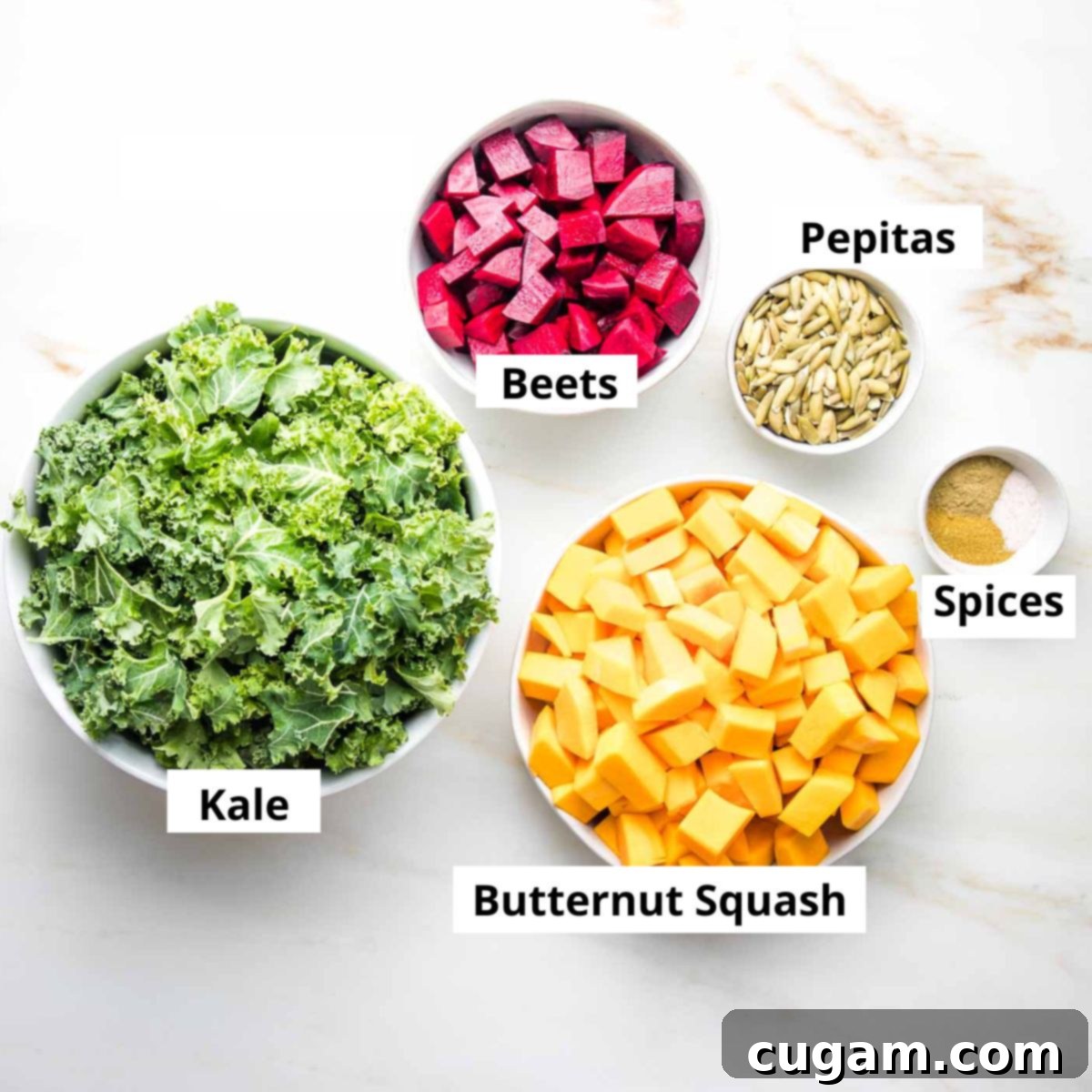
- Kale: The sturdy base of our salad, kale is a nutritional powerhouse loaded with antioxidants, vitamins A, C, and K, and plenty of fiber. Its robust texture holds up beautifully to the heavier roasted vegetables and creamy dressing. If curly kale isn’t your preference, feel free to substitute with other nutrient-dense greens like peppery arugula, delicate spinach, hearty collard greens, or colorful Swiss chard. For an extra tender touch, Lacinato kale (also known as dinosaur kale) stacked and sliced thin is a fantastic alternative.
- Butternut Squash: This sweet and nutty winter squash is not only delicious but also highly nutritious. It’s low on the glycemic index, high in fiber, and packed with vitamins A and C, and essential minerals like potassium. Its natural sweetness intensifies beautifully when roasted. Great substitutes include other winter squash varieties like delicata (which doesn’t require peeling!), acorn, or honeynut squash. Sweet potatoes also make an excellent stand-in and often roast even faster.
- Beets: These vibrant root vegetables are more than just pretty; they are a fantastic source of fiber, folate, manganese, potassium, and iron. Beets are well-known for their anti-inflammatory properties, their ability to help lower blood pressure, and their natural energy-boosting compounds. Their earthy sweetness perfectly balances the butternut squash.
- Pepitas: Also known as pumpkin seeds, pepitas add a delightful crunch and a wealth of nutrition to this salad. They are loaded with antioxidants, plant-based protein, and fiber, making them a healthy addition. If you don’t have pepitas on hand, you can easily substitute them with other crunchy nuts or seeds like walnuts, pistachios, almonds, pecans, or sunflower seeds. Each option will add its own unique flavor profile.
How to Effortlessly Peel and Dice Butternut Squash
Preparing butternut squash might seem daunting at first, but with a few simple steps and the right tools, it becomes quite easy. First, always wash the outside of the squash thoroughly to ensure no dirt or impurities transfer onto the flesh when you cut into it. For safe and efficient preparation, you’ll need a sharp chef’s knife and a sturdy wooden cutting board.
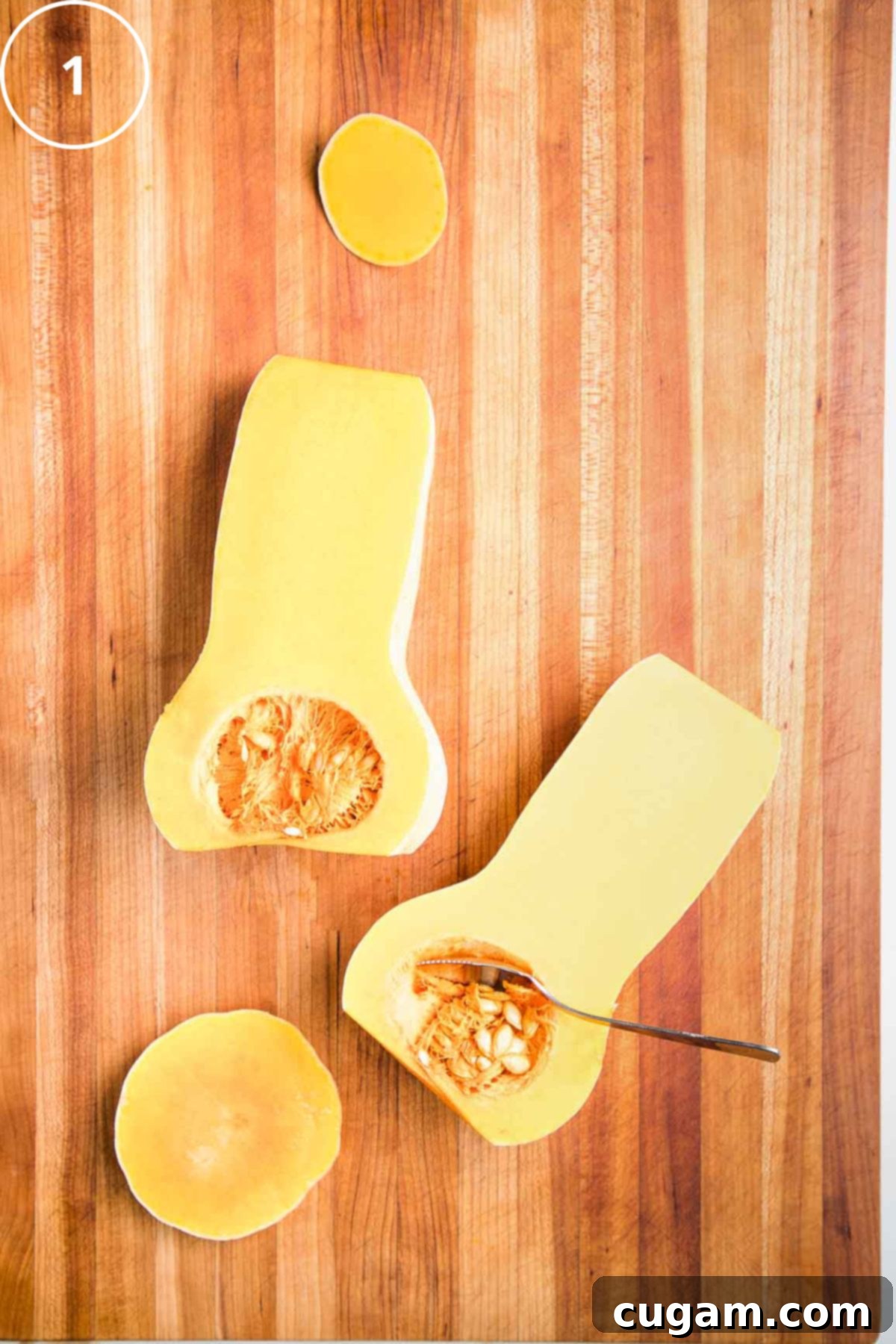
Step 1: Stabilize and Halve. To make the squash safe and easy to cut, first slice a small sliver off the bottom so it can sit flat and stable on your cutting board. Then, cut a similar sliver off the top. Carefully cut the squash lengthwise down the middle. Once halved, a grapefruit spoon or a regular sturdy spoon makes it incredibly easy to scoop out the seeds and stringy membranes from the cavity.
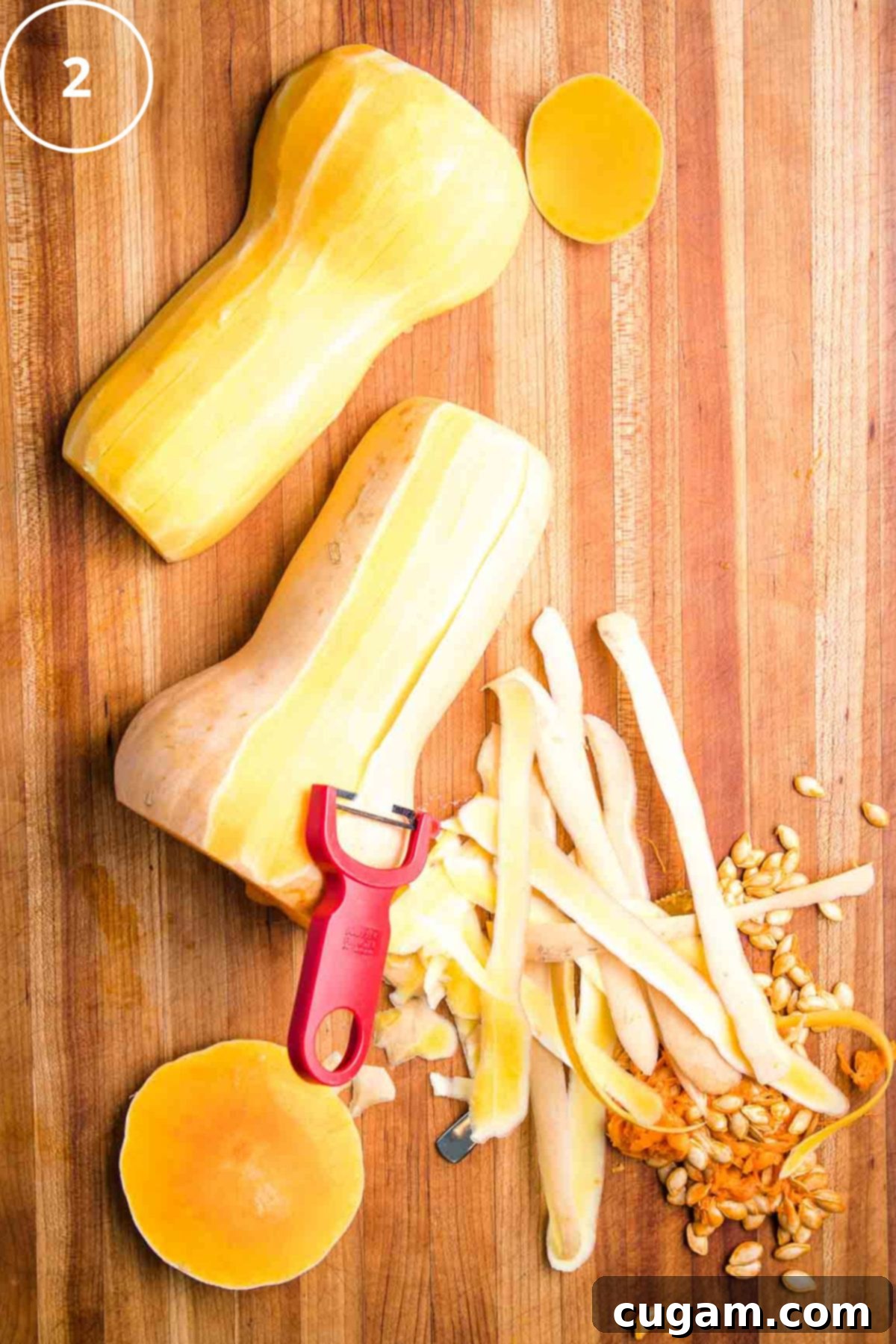
Step 2: Peel the Skin. Turn the squash halves skin side down on your cutting board for stability. Use a “Y” vegetable peeler to carefully remove the tough outer skin. You might need to go over certain areas twice if the skin is particularly thick or stubborn.
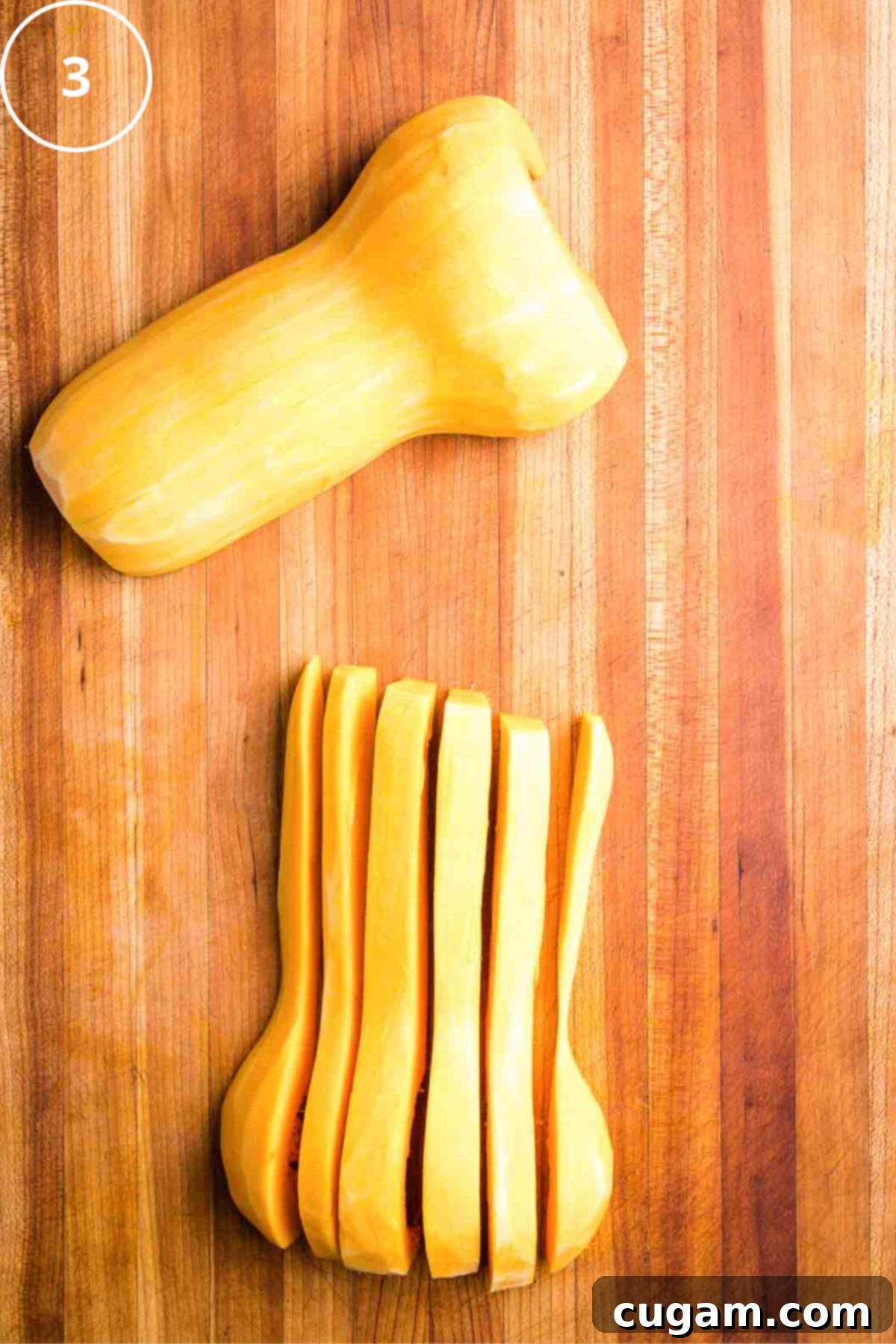
Step 3: Slice into Strips. With the squash now peeled, place the flat side down on the cutting board. Carefully cut the squash into ½-inch thick strips lengthwise. Aim for even thickness to ensure uniform cooking.
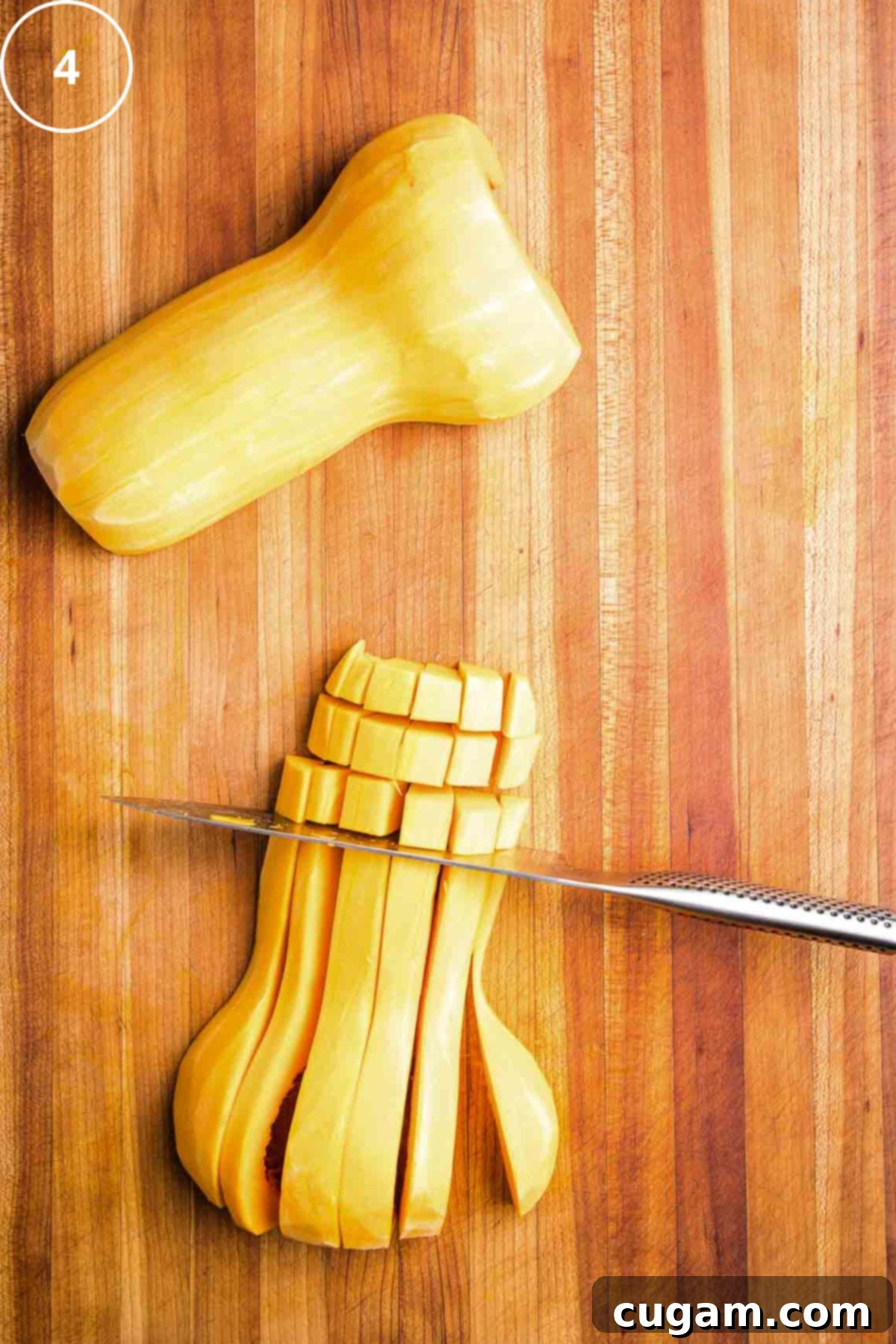
Step 4: Dice into Cubes. Arrange the strips neatly on your cutting board. Then, cut across the strips to create uniform ½-inch cubes. These small, even cubes will roast beautifully, becoming tender on the inside and slightly caramelized on the outside.
Perfectly Roasting Winter Squash and Beets
Roasting vegetables is one of my favorite easy meal prep tips – and for good reason! It transforms humble veggies into incredibly flavorful, sweet, and tender bites, ready to elevate any meal. This beetroot and butternut squash salad relies on this simple technique, and the roasted components are ready in just 20 minutes.
To maximize your time and oven efficiency, I always recommend roasting multiple types of vegetables on different trays at once. Once roasted, these versatile veggies can be stored in the fridge for up to a week, ready to be tossed into salads, mixed into grain bowls, stuffed into burritos, or even added to a savory veggie scramble. For easier cleanup, you can line your baking sheets with unbleached parchment paper. However, for those irresistible crispy edges, I often prefer to roast my veggies directly on the baking pan.
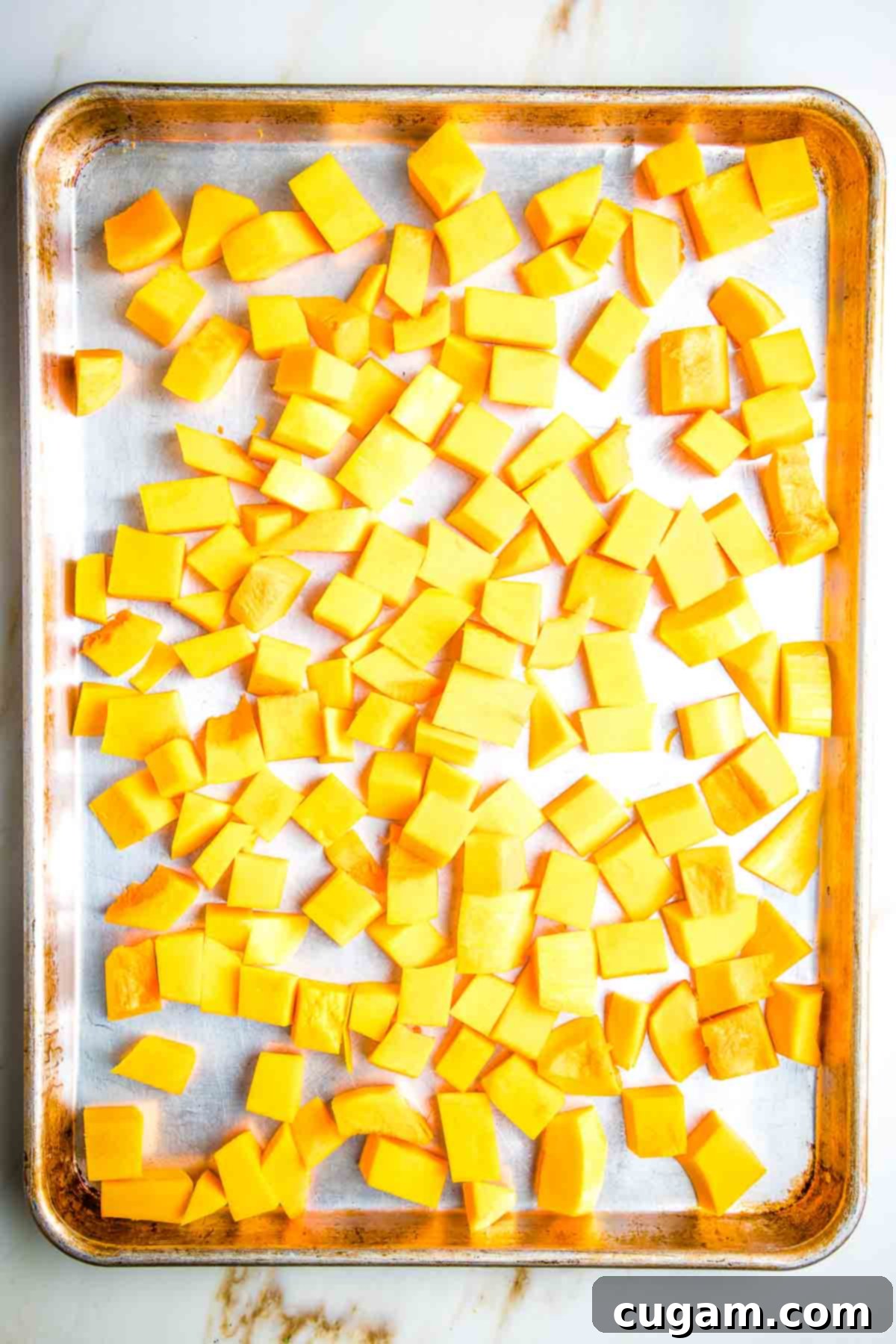
Place your uniformly diced butternut squash cubes onto a large rimmed baking tray. Ensure they are spread in a single layer without overcrowding, which allows them to roast rather than steam.
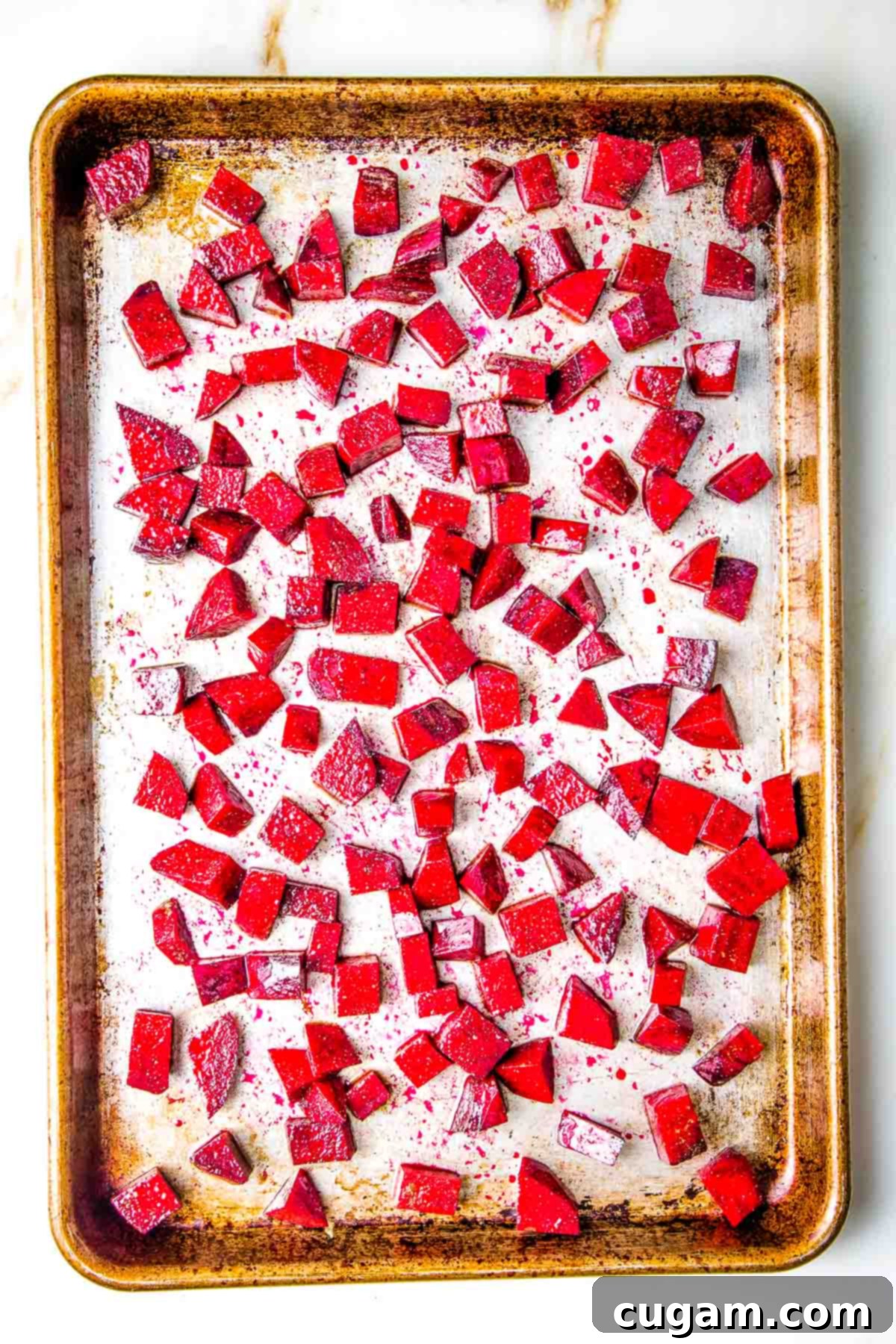
On a separate tray, place your diced beets. For beets, there’s no need to peel them before dicing if you’re in a hurry; the skins become tender during roasting. However, peeling them will result in a more uniform texture and vibrant color.
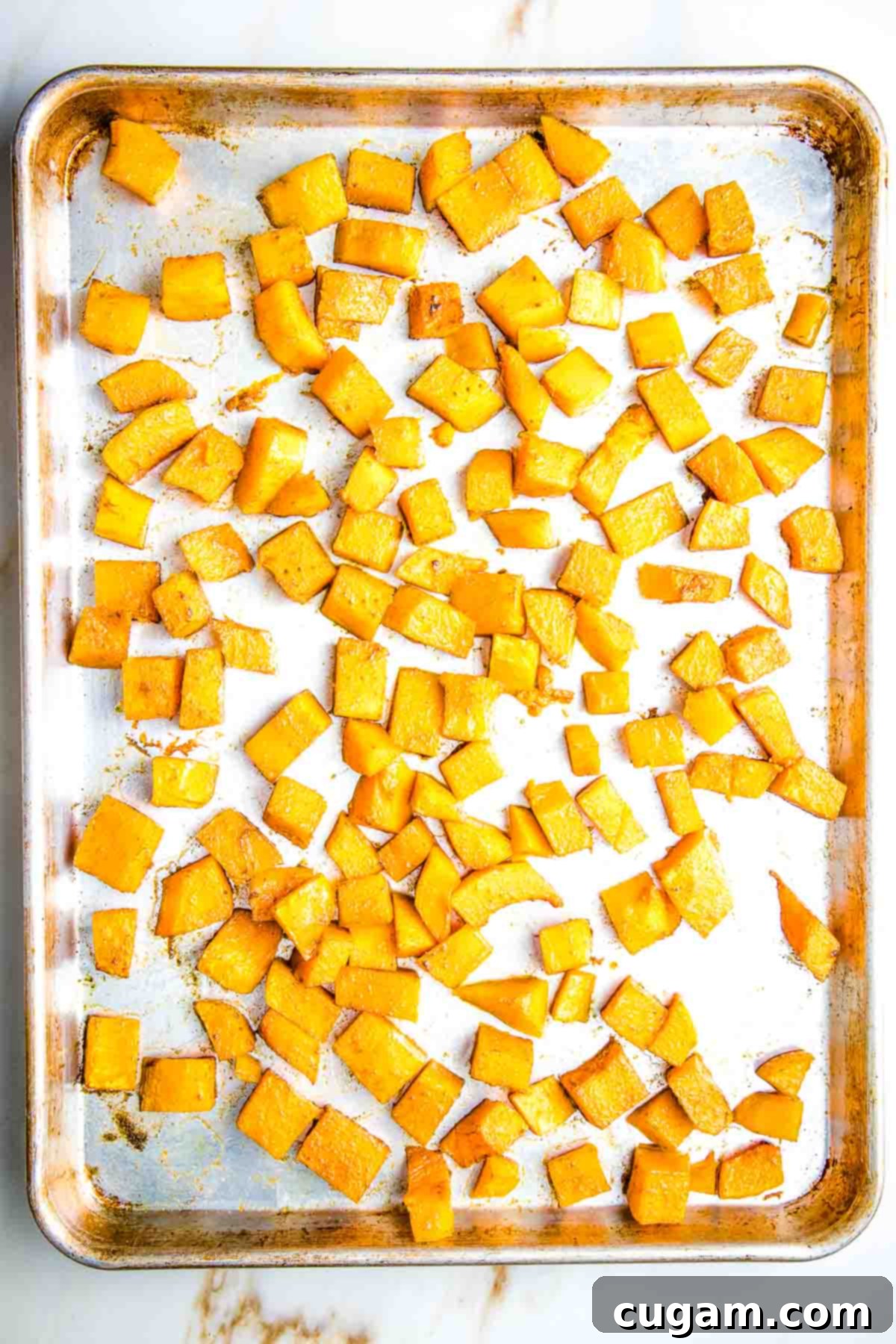
Drizzle each tray generously with good quality olive oil. Then, season both the squash and beets with a fragrant blend of dried sage, ground cumin, and a sprinkle of coarse sea salt. These spices truly bring out the earthy and sweet notes of the vegetables. Roast in a preheated 400°F (200°C) oven for approximately 20 minutes.
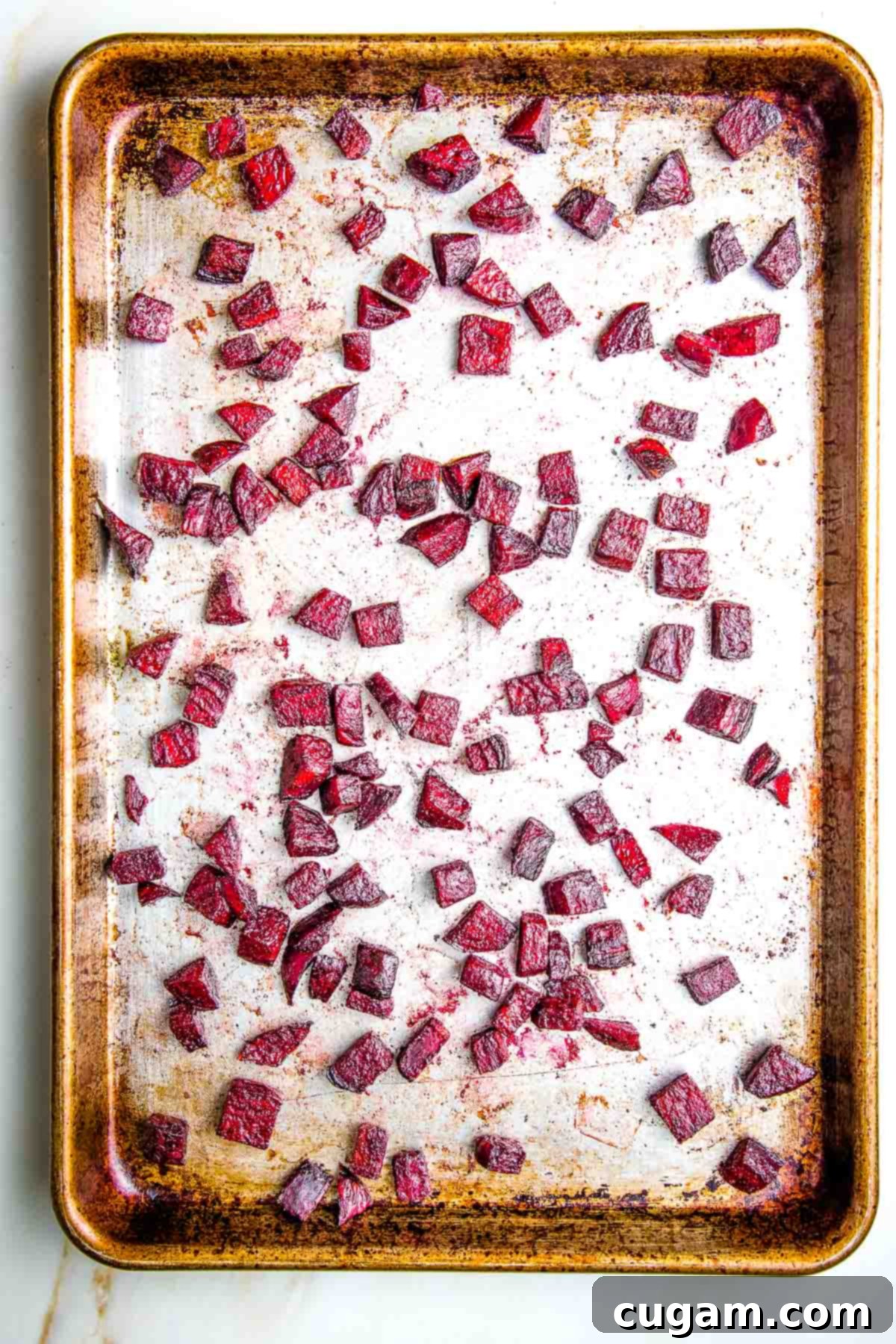
The goal is perfectly roasted vegetables that are soft and tender when pierced with a fork, yet still hold their shape beautifully and are not mushy. Look for slightly caramelized edges, which indicate maximum flavor development. The beets will deepen in color and the squash will turn a golden hue.
The Star of the Show: Creamy, Vegan Balsamic Dressing
I am absolutely head-over-heels obsessed with this creamy tahini balsamic dressing. It’s a true secret weapon in the kitchen, and the best part? It whisks together in just 2 minutes flat! This dressing offers a wonderfully rich and creamy texture, yet it’s completely free of dairy and added oils. It strikes the perfect balance between tangy and sweet, blending seamlessly with all the other components of the salad.
To make it, simply combine tahini (which provides that luxurious creaminess), balsamic vinegar for its delightful tang, Dijon mustard for a little kick, pure maple syrup for natural sweetness, your choice of spices, and a touch of water to achieve the perfect pourable consistency. You’ll find the specific measurements for this magical concoction in the recipe card below. This dressing is so versatile, you’ll want to put it on everything!
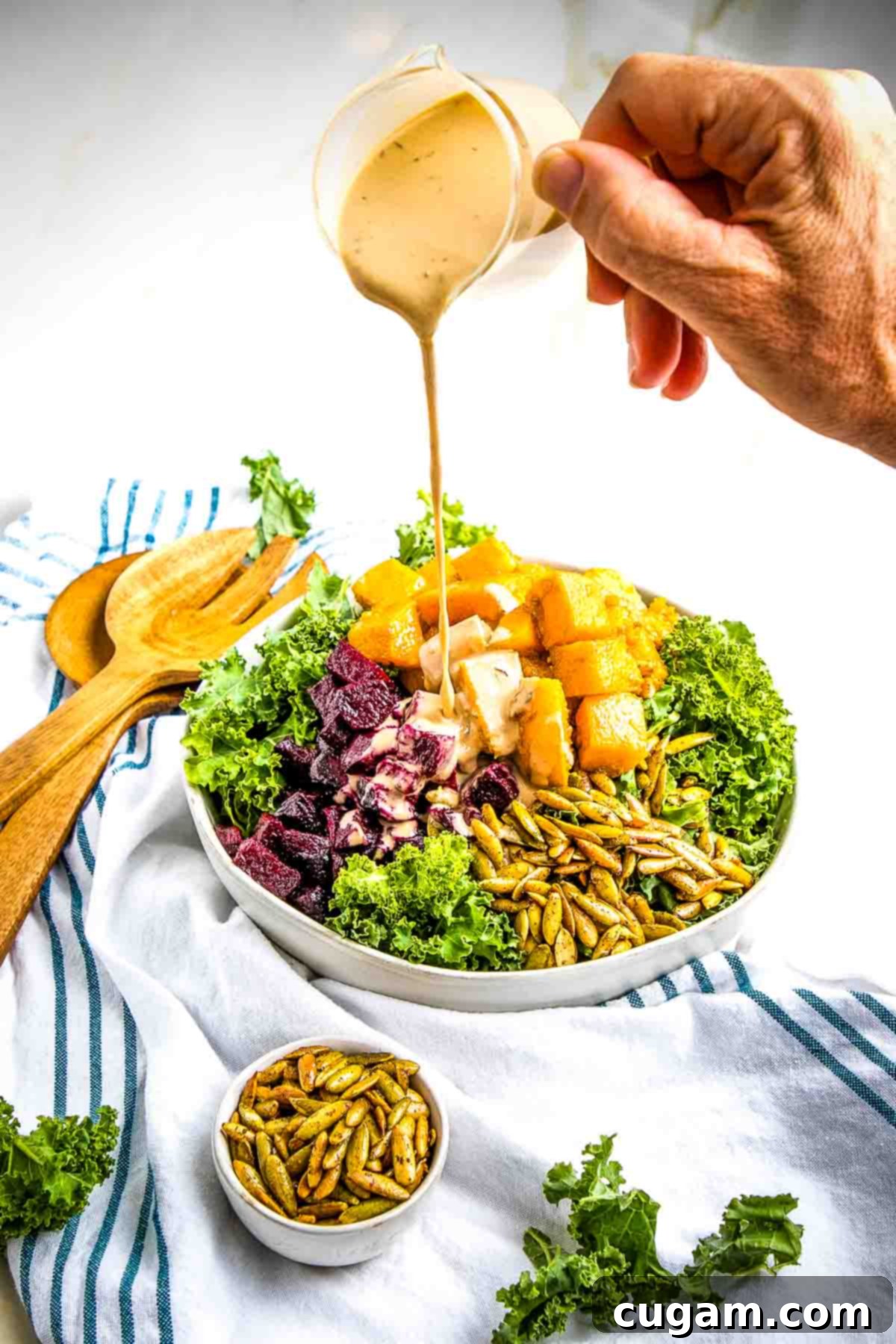
Assembling Your Delicious Salad
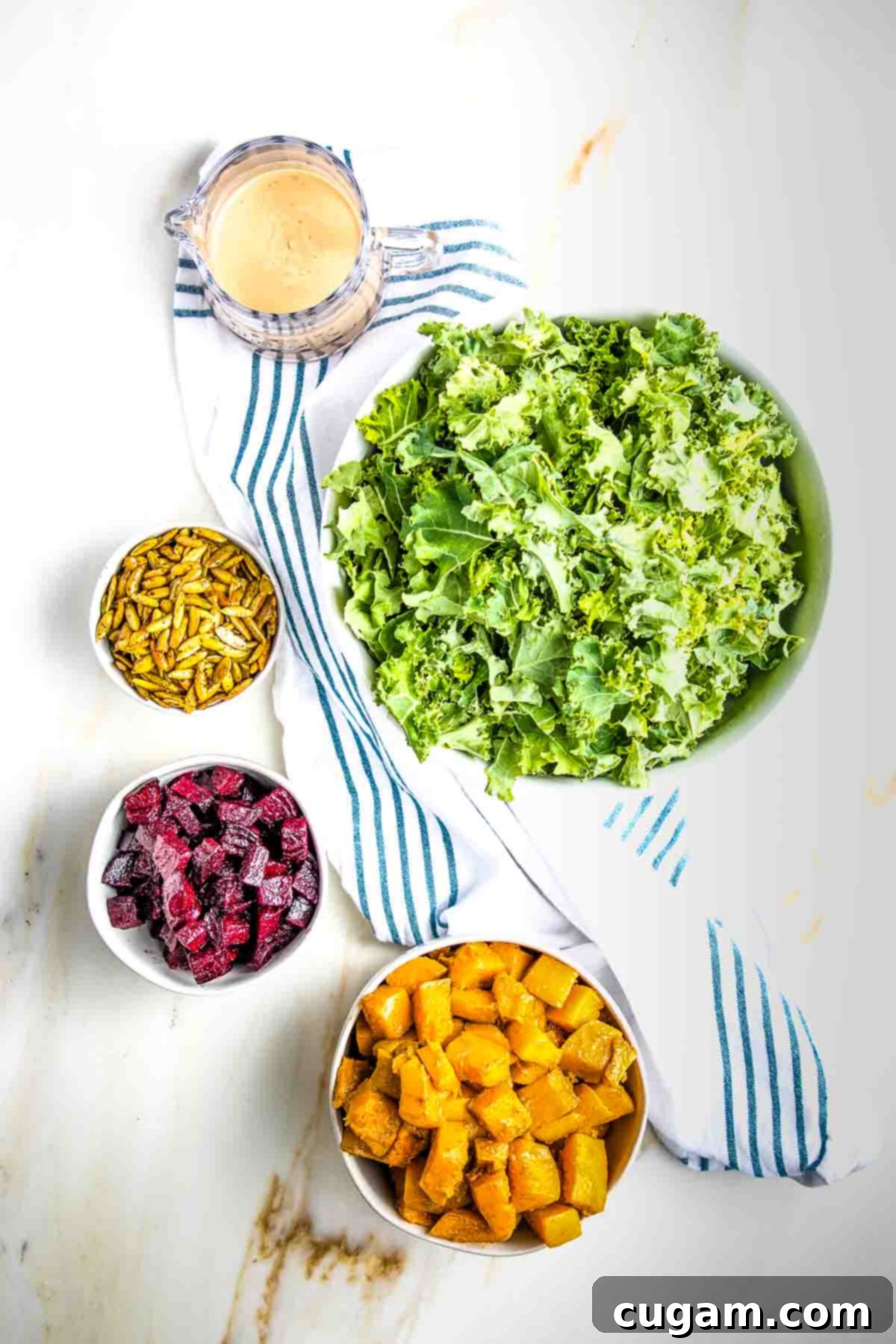
- Massage the Kale for Tenderness: Start by placing your kale (torn into bite-sized pieces) in a large bowl. Lightly massage the kale with your hands for a few minutes. This simple technique breaks down the fibrous texture, making the kale much more tender, palatable, and easier to digest. You don’t need any oil or dressing to achieve this; just the warmth and gentle pressure of your hands will soften it beautifully. Stop when the kale feels noticeably softer and slightly darker green.
- Toasting Pepitas for Maximum Flavor: This step is crucial for enhancing the nutty flavor and adding an irresistible crunch! Place the raw pumpkin seeds (pepitas) in a dry skillet, preheated over medium heat. I highly recommend using a cast iron skillet for even heat. As the seeds toast, they’ll release some of their natural oils and become incredibly fragrant. Add a sprinkle of cumin and sea salt partway through, and continue to shake the pan or stir frequently to prevent burning. They’re done when golden brown and aromatic, typically in 4-5 minutes.
- Combine and Dress: Once the roasted squash and beets are slightly cooled and the pepitas are toasted, add them to the large bowl with the massaged kale. Pour about half of the prepared creamy balsamic dressing over the top. Toss everything together gently but thoroughly, ensuring all ingredients are well coated. Taste and add more dressing if desired, or serve the remaining dressing on the side for guests to customize their own portions.
Smart Time-Saving Tips for Busy Cooks
Life gets busy, and there’s absolutely no shame in taking a few clever shortcuts if it means you’ll actually get to make and enjoy this delicious, healthy butternut squash salad more often. Here are some of my favorite ways to shave off precious minutes:
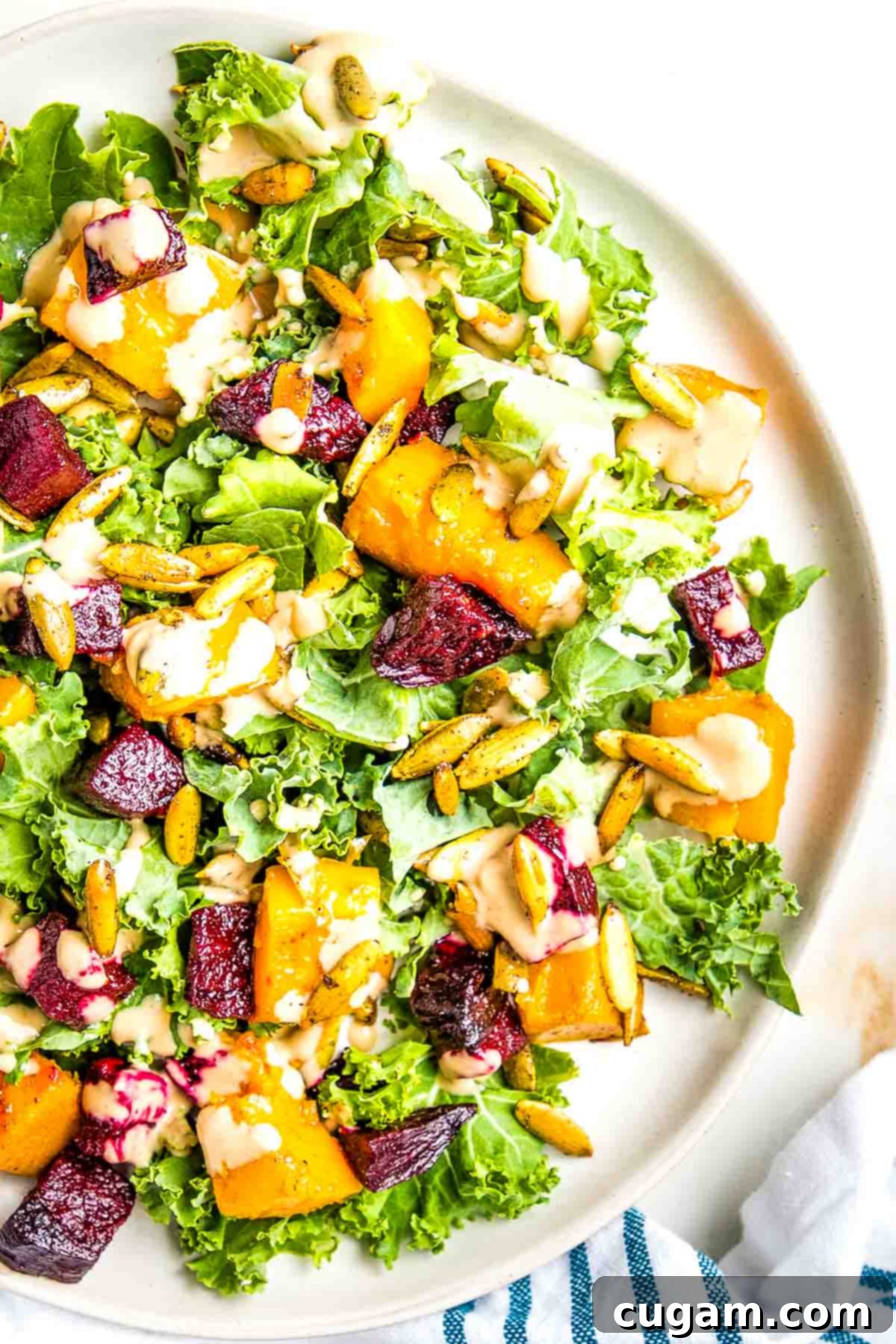
- Pre-Prepped Butternut Squash: Skip the peeling and dicing entirely! Many grocery stores now offer butternut squash that is already peeled and cubed in the produce section. This can be a huge time-saver.
- Strategic Meal Prep Roasting: Don’t just roast for this salad. Whenever you have your oven on for another recipe, maximize its use by roasting a larger batch of squash and beets in advance. Store the cooled veggies in an airtight container in the fridge, and they’ll be ready for your salad (or other meals) all week long.
- Buy Pre-Roasted Nuts/Seeds: While toasting them fresh is fantastic, buying nuts or seeds that are already roasted and salted is a quick way to add crunch and flavor without an extra step. Just check the ingredient list for unwanted oils or additives.
- Make the Dressing Ahead: This creamy balsamic dressing is super stable. Whisk together all the ingredients and store it in a glass jar in the fridge for up to two weeks. It’ll be perfectly ready whenever a salad craving strikes.
- Pre-Washed Greens: Opt for pre-washed and ready-to-serve greens, like bagged kale or spinach, to eliminate the washing and drying steps. This simple switch can save a surprising amount of time in your meal preparation.
Storage & Serving Recommendations
To keep your salad components fresh and delicious, store them separately until you’re ready to serve. The roasted butternut squash and beets will last well in an airtight container in the refrigerator for up to 5-7 days. The toasted pepitas can be kept at room temperature in a sealed glass jar for up to 3 weeks, maintaining their crunch. The dairy-free balsamic dressing is also fridge-friendly for up to 2 weeks.
When serving, this salad is delightful both warm and at room temperature. For a heartier meal, consider adding a protein like seasoned chickpeas, lentils, or grilled tofu. It pairs wonderfully with a simple roasted chicken or fish, making it a versatile addition to any meal.
Discover More Cozy Winter Salad Recipes
If you’ve fallen in love with this hearty butternut squash and beetroot salad, you’ll be thrilled to explore other delicious and nutritious winter salad options. These recipes are designed to bring warmth, flavor, and vibrant ingredients to your table even on the chilliest days. They’re perfect for keeping your meals exciting and healthy throughout the colder months.
- Fall Harvest Salad with Apple Vinaigrette
- Lentil Salad with Roasted Vegetables
- Tuscan Kale Chopped Salad
- Kidney Bean Salad Recipe
Did you know commenting and rating recipes is one of the best ways to support your favorite food bloggers? If you made this delicious recipe, please consider leaving a five-star rating below and sharing your thoughts in a comment. Also, we’d love to see your culinary creations! Please share your photos on instagram by tagging me @dkhealthcoach and using the hashtag #debraklein.
📖 Recipe
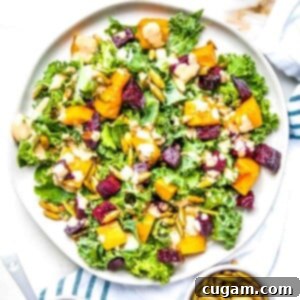
Roasted Butternut Squash and Beetroot Salad
Rate this Recipe
Pin Recipe
Ingredients
- 1 large bunch of curly kale*
For the Butternut Squash + Beets
- 1 large butternut squash *
- 4 large red beets *
- 2 Tablespoons olive oil
- 1 teaspoon dried sage
- 1 teaspoon dried cumin
- ½ teaspoon coarse sea salt
For the Pepitas (Toasted Pumpkin Seeds)
- ½ cup raw hulled pepitas pumpkin seeds.
- ½ teaspoon dried cumin
- ¼ teaspoon coarse sea salt
For the Creamy Balsamic Dressing:
- ¼ cup tahini
- ¼ cup water
- 1 Tablespoon balsamic vinegar
- 1 Tablespoon Dijon Mustard
- 2 teaspoons maple syrup
- 1 teaspoon dried thyme
- ½ teaspoon sea salt
- ¼ teaspoon white pepper
Instructions
-
Preheat your oven to 400°F (200°C). Prepare two large, rimmed baking sheets. For significantly easier cleanup, you have the option to line them with unbleached parchment paper.
-
Prepare Veggies for Roasting: For the butternut squash, first wash its exterior thoroughly. Trim off both ends, then carefully halve it lengthwise. Scoop out the seeds and stringy membranes. Use a vegetable peeler to remove the tough skin, then cut the squash into ½-inch strips lengthwise, followed by cutting across to create uniform ½-inch cubes. Place these cubes on one of the prepared baking sheets. For the beets, trim the ends and peel them (optional, but recommended for smoother texture). Dice the peeled beets into ½-inch cubes and place them on the second baking pan. Drizzle both trays of veggies generously with olive oil, then evenly sprinkle with dried sage, ground cumin, and sea salt. Toss gently to coat.
-
Roast the Vegetables: Transfer both baking sheets to the preheated 400°F (200°C) oven and roast for approximately 20 minutes. The vegetables are done when they are soft and tender when pierced with a fork, but still hold their shape and are not mushy. Look for slight caramelization on the edges.
-
Make the Creamy Dressing: While the vegetables are roasting, prepare the dressing. In a medium bowl, simply whisk together the tahini, water, balsamic vinegar, Dijon mustard, maple syrup, dried thyme, sea salt, and white pepper until smooth and well combined. If the dressing is too thick for your liking, add additional water, one tablespoon at a time, until you reach your desired pourable consistency. Set aside.
-
Toast the Pumpkin Seeds: Meanwhile, heat a dry skillet over medium-high heat. Add the raw hulled pepitas (pumpkin seeds) to the hot pan. Toast them, shaking the pan often to prevent burning, until they begin to brown, become fragrant, and start to “pop” slightly. As they toast, they will release natural oils. Sprinkle them with the dried cumin and sea salt. Continue to shake or stir until they are golden brown and aromatic. This entire process typically takes 4-5 minutes. Immediately transfer the toasted pepitas to a plate to cool and prevent further cooking.
-
Assemble the Salad: If you’re using curly kale, first rip it into bite-sized pieces. Place the kale in a large mixing bowl and gently massage it with your hands for a few minutes until it softens and becomes more tender. Transfer the massaged kale to a large serving platter or bowl. Add the slightly cooled roasted butternut squash, roasted beets, and the toasted pepitas. Drizzle about half of the creamy balsamic dressing over the top. Toss everything together thoroughly until all ingredients are well coated with the dressing. Taste and add more dressing if desired, or serve the remaining dressing on the side for individual preference.
-
Storage Tips: Store any leftover roasted squash or beets in an airtight container in the refrigerator for up to a week. They are fantastic on top of other salads, stirred into soups, added to grain bowls, or mixed into breakfast scrambles. Extra toasted pepitas can be stored at room temperature in a glass jar for up to 3 weeks to maintain their crunch. The prepared dressing will keep well in the fridge for up to 2 weeks.
Notes
BEETS: Four large beets will generally yield about 2-3 cups once peeled and diced. Keep in mind that beets will shrink considerably during the cooking process, so it’s a good idea to err on the side of making a bit more than you anticipate needing for your salad.
GREENS: This versatile salad allows you to use any type of greens or a combination that you enjoy. I’ve specifically used curly kale in this recipe because its robust texture holds up exceptionally well to the hearty roasted vegetables and creamy dressing. Lacinato kale (dinosaur kale), when stacked and sliced thin, is another excellent option that provides a slightly different, more tender bite. If you prefer a less fibrous base, peppery arugula or tender spinach will also work beautifully, and with these greens, you can skip the massaging step as they are naturally more delicate.
Nutrition
Note
The nutrition calculations were done using online tools. To obtain the most accurate representation of the nutritional information in any given recipe, you should calculate the nutritional information with the actual ingredients you used. You are ultimately responsible for ensuring that any nutritional information is accurate, complete and useful.
